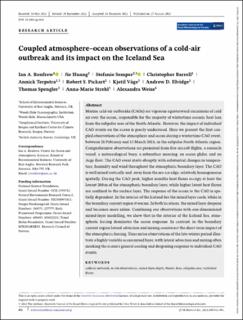Coupled atmosphere–ocean observations of a cold-air outbreak and its impact on the Iceland Sea
Renfrew, Ian A.; Huang, Jie; Semper, Stefanie; Barrell, Christopher; Terpstra, Annick; Pickart, Robert S.; Våge, Kjetil; Elvidge, Andrew D.; Spengler, Thomas; Strehl, Anna-Marie; Weiss, Alexandra
Journal article, Peer reviewed
Published version

Åpne
Permanent lenke
https://hdl.handle.net/11250/3063336Utgivelsesdato
2023Metadata
Vis full innførselSamlinger
- Geophysical Institute [1195]
- Registrations from Cristin [9766]
Originalversjon
Quarterly Journal of the Royal Meteorological Society. 2023, 149 (751), 472-493. 10.1002/qj.4418Sammendrag
Marine cold-air outbreaks (CAOs) are vigorous equatorward excursions of cold air over the ocean, responsible for the majority of wintertime oceanic heat loss from the subpolar seas of the North Atlantic. However, the impact of individual CAO events on the ocean is poorly understood. Here we present the first coupled observations of the atmosphere and ocean during a wintertime CAO event, between 28 February and 13 March 2018, in the subpolar North Atlantic region. Comprehensive observations are presented from five aircraft flights, a research vessel, a meteorological buoy, a subsurface mooring, an ocean glider, and an Argo float. The CAO event starts abruptly with substantial changes in temperature, humidity and wind throughout the atmospheric boundary layer. The CAO is well mixed vertically and, away from the sea-ice edge, relatively homogeneous spatially. During the CAO peak, higher sensible heat fluxes occupy at least the lowest 200 m of the atmospheric boundary layer, while higher latent heat fluxes are confined to the surface layer. The response of the ocean to the CAO is spatially dependent. In the interior of the Iceland Sea the mixed layer cools, while in the boundary current region it warms. In both locations, the mixed layer deepens and becomes more saline. Combining our observations with one-dimensional mixed-layer modelling, we show that in the interior of the Iceland Sea, atmospheric forcing dominates the ocean response. In contrast, in the boundary current region lateral advection and mixing counteract the short-term impact of the atmospheric forcing. Time series observations of the late-winter period illustrate a highly variable ocean mixed layer, with lateral advection and mixing often masking the ocean's general cooling and deepening response to individual CAO events.
